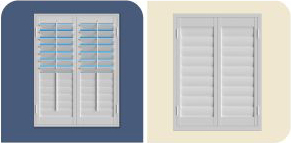
3 Ways Polywood Shutters Are A Better Choice Than Hollow Vinyl And Composite Shutters In Phoenix, AZ
December 15, 2015
The market for plantation shutters in Phoenix is full of options. And when you are figuring out which non-wood shutter is the best for your home, it might be hard to discern the differences. You can unknowingly choose the wrong type and find yourself purchasing shutters that aren’t durable. When it comes to solid polymer shutters, like our best-selling Polywood® shutters, are they a better investment than MDF (multi-density fiberboard) or hollow vinyl shutters? Find out the three ways Polywood shutters are a better choice than composite shutters in Phoenix, AZ .
1. Polywood vs Composite Shutters Durability
Polywood shutters are crafted from high quality solid polymer that leads to the most color-retention, durability, and rigidity than any other shutter you can find. This means the shutter louvers won’t warp over time. In contrast, composite shutters are constructed from a pressed-board core, wrapped with poly-vinyl. The vinyl wrapping the pressed board also peels away from the core material easily. And this peeling happens even faster in hot, humid, and wet environments. Non-wood shutters are also available as hollow vinyl shutters. But they deteriorate the fastest in large part due to the elements.Both kinds of non-wood shutters are susceptible to deterioration and warping when exposed to the different climate conditions in Phoenix. Polywood is crafted with UV inhibitors that deflect heat. And because heat is the major offender in cracking the shutter louvers, Polywood is absolutely the longest lasting plantation shutter you can find.
2. Polywood vs Composite Shutters Color Fastness
Polywood shutters come in three premium white paints. The paint finishes are baked on each element at hotter temperatures than Phoenix has seen. This patented finishing process applies UV inhibitors to ensure the color will never fade.
Other types of non-wood shutters finishes are limited to either low quality paint finish or no paint finish at all. In a lot of cases, the vinyl wrap is the all the color you get. This finish may look good initially, but it fades with time. And some hollow vinyls are painted. However, with the material easily conducting heat, this seriously influences the finish over time.
3. Polywood vs Composite Shutters Energy Efficiency
Third party tests illustrate that Polywood shutters lead to reduction of heat transfer by up to 45% and insulate against 30° of temperature. That’s how Polywood insulates up to 70% better than a similar solid wood shutter.
Polywood’s insulating properties are a result of the solid polymer material. But what sets Polywood apart even more from composite shutters is the weatherstripping on louvers and panels. Simply interlock the pieces of weatherstripping as you close the panels. This gives you a very tight seal against the weather conditions outside. You won’t find all the energy savings that Polywood offers in any composite shutter.
Our Team In Vegas Experiences The Durability Of Polywood Shutters First Hand
In 2004, Sunburst Shutters Las Vegas had Polywood shutters anchored to the sides of their trucks as part of the graphics. They were parked outside and endured the natural elements Vegas is famous for. We’re talking excessive heat for more than five months a year!
Those shutters had been fastened to our vehicles for more than 7 years. That’s when our team organized an investigation on how well Polywood retained the color painted on it. So we wiped the Polywood shutter that was on the truck clean. And we held up a new Polywood shutter next it for comparison. The color was the same. We didn’t see any discoloration or fading. It further validated for us that the Sunburst paint finish is the best in the market!
And with Polywood withstanding that much abuse and heat travelling on a truck for over 7 years, it’s without a doubt the long lasting shutter for your home in Phoenix, AZ.


